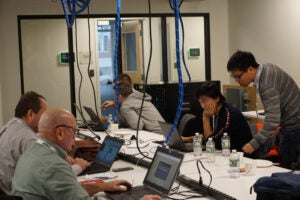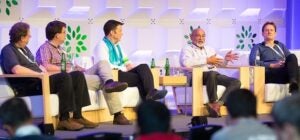OPNFV made progress at its second Plugfest in advancing interoperability with other open source platforms, notably integration of the OPNFV platform with both the Open Compute Project and Open Orchestrator Project.
Read more at Telco Transformation.
OPNFV made progress at its second Plugfest in advancing interoperability with other open source platforms, notably integration of the OPNFV platform with both the Open Compute Project and Open Orchestrator Project.
Read more at Telco Transformation.
The somewhat long-awaited report on OPNFV’s December Plugfest emerged this morning, revealing no major surprises but taking some steps forward on integration with other open source projects, namely the Open Compute Project and Open Orchestrator.
Read more at Light Reading.
By Lincoln Lavoie, senior engineer, Broadband Technologies, University of New Hampshire InterOperability Laboratory (UNH-IOL)
 Wrapping up the OPNFV Colorado release work in 2016, the OPNFV Plugfest and co-located Hackfest in December brought together 70 participants from 23 different organizations. The international group, traveling in from Asia, Europe, and North America, converged at the UNH InterOperability Laboratory (UNH-IOL) in Durham, NH for a full week of activities. Fueled by coffee, snacks, fancy chocolates (someone brought from afar), and more coffee, participants spent the week running tests and various deployment scenarios, working with on- and off-site hardware and the development teams. The testing focused on two key areas: 1) deployment testing with different hardware/software combinations and 2) Open-O integration with OPNFV. There were also some Hackfest development and testing efforts: 1) multi-site deployment and 2) enabling OPNFV Doctor. In all cases, teams of developers were able to identify bugs or enhancements to complete the task at hand, with the identified issues being reported as part of the Plugfest’s white paper. Rest assured, JIRA tickets have also been created and worked for each item as well!
Wrapping up the OPNFV Colorado release work in 2016, the OPNFV Plugfest and co-located Hackfest in December brought together 70 participants from 23 different organizations. The international group, traveling in from Asia, Europe, and North America, converged at the UNH InterOperability Laboratory (UNH-IOL) in Durham, NH for a full week of activities. Fueled by coffee, snacks, fancy chocolates (someone brought from afar), and more coffee, participants spent the week running tests and various deployment scenarios, working with on- and off-site hardware and the development teams. The testing focused on two key areas: 1) deployment testing with different hardware/software combinations and 2) Open-O integration with OPNFV. There were also some Hackfest development and testing efforts: 1) multi-site deployment and 2) enabling OPNFV Doctor. In all cases, teams of developers were able to identify bugs or enhancements to complete the task at hand, with the identified issues being reported as part of the Plugfest’s white paper. Rest assured, JIRA tickets have also been created and worked for each item as well!
Deployment testing combined on-site hardware resources from Huawei, Lenovo, and Nokia, and off-site resources from ENEA, Huawei, Intel, and NEC. The Lenovo and Nokia hardware based on the Open Compute Project (OCP) hardware designs, representing the first time this type of hardware had been tested at an OPNFV event (open source running on open hardware). While the OCP hardware isn’t specifically designed for OPNFV, it’s high density designs, with dedicated high-speed network interfaces, the designs align very well with the requirements for the NFV architectures. The teams worked together to deploy one or more of the OPNFV installers/scenarios on each set of hardware, and once completed, used OPNFV testing tools, such as Functest, Qtip, and StorePerf to test the NFV platform (refer to the white paper for a full list of tested installer/scenarios and hardware combinations).
While the Plugfest participants were busy, Hackfest participants were no slackers either. The event schedules were packed, with project teams meeting throughout the week. Some of the “full room” discussions included the Colorado release retrospective, finalization of the Pharos pod descriptor file, and the cross community CI activities–specifically with the OpenDaylight and Open-O projects.
Looking to the Spring (and warmer weather), the date and location of the next OPNFV Plugfest & Hackfest have just been announced: April 24-28, in Paris, France at the Orange campus. With all the work completed at this event, the bar has been set high, but maybe we can create some additional motivation during the Plugfest with the promise of French wine at the end of the day. We hope to see many of you in Paris. In the meantime, please check out the OPNFV Plugfest Report: Lessons and Results from the Second OPNFV Plugfest (December 2016) and let us know if you have any feedback, questions, or ideas.
The Linux Foundation’s Open Platform for NFV project is looking to unveil a new platform release over the next two months, which will be the fourth platform targeting open source deployments of network functions virtualization.
Read more at RCR Wireless.
We kicked off our intern program a few months back and are pleased to welcome our first group of OPNFV interns! They work directly with the community and receive hands-on development experience in NFV. Each intern works closely with an active OPNFV developer as their mentor on a project that suited interest and community need. This blog series aims to showcase these interns and the projects they work on, the mentors who are helping with their professional development, and their experience working in an open source community to help accelerate NFV.

About Akshita (in her own words):
I am Akshita Jha, currently in my final year of a dual-degree course of B. Tech in Computer Science and MS by Research in Computational Linguistics from the International Institute of Information Technology, Hyderabad (IIIT-H), India. I love development and contributing to open source projects. I am also interested in NFV, Machine Learning and Artificial Intelligence. In my free time, I like to paint and love trying out different cuisines.
Currently, I am working on ODL –>OPNFV integration for better automating package builds, adding .deb support to OpenDaylight’s configuration management tooling (Ansible, Puppet) and pre-built images (Docker, Vagrant) and working with OPNFV installers to help them use upstream tooling (upstream/improve JOID’s ODL JuJu Charms, help Compass use Ansible role with .deb/RPMs).
How did you hear about OPNFV and what got you interested in this internship?
I first heard about OPNFV during my internship with OpenDaylight in Summer 2016. As an ODL intern, I worked on creating a .deb package for OpenDaylight. One of the best things about this project was that it enabled OPNFV installers that support non-CentOS scenarios (JOID, Compass) to consume ODL pretty easily, using upstream tools. I attended OpenDaylight Summit 2016 in Seattle, WA where I got a chance to interact with inspiring people from the OPNFV community. We spoke about the scope of ODL–>OPNFV integration and that resulted in this internship.
Can you talk about your experience working on an open source project? Any previous experiences you can share or key learnings from working on OPNFV so far?
I had the opportunity to work with Debian as a Google Summer Of Code intern in 2015 and as I have previously mentioned, as an OpenDaylight intern in 2016. Most of my technological knowledge is due to my experience with open source projects. I feel the best way to learn a technology is to contribute to an open source project that uses that technology. The constructive feedback that you receive on your code from the community helps a lot. In the beginning, I remember being miffed about receiving continuous -1’s on a gerrit code-review! I now understand that the willingness to take that criticism and improve the code is what makes you a better developer. It’s about sharing and learning through collaboration.
Another, amazing thing about an open source project is that you can see the real-life impact of your work. What makes it even more appealing is that the entire source code is ‘open’. Moreover, you are aware of the entire pipeline of the product. And in case of any confusion, you can always reach out to the community for help.
What’s the best thing you’ve learned from your internship?
I have learned a lot from my internship. I was relatively new to many concepts and I found myself asking, more than once. ‘am I good enough?’. But over time I realised that it’s a mental block more than anything else. One step at a time. One small task, one small bug at a time and voila! before you know it, you have the solution to the problem you thought was impossible to solve. I think this is the best thing I learned during my internship.
Who is your mentor and what’s the experience been like?
My mentor for ODL–>OPNFV integration project is Daniel Farrell. He is the Project Technical Lead of OpenDaylight Integration/Packaging, committer to Integration/Test, OpenDaylight TSC member, PTL of OPNFV’s Controller Performance Testing project (Cperf) and committer to the CentOS NFV SIG. My experience with him has been wonderful. From the very beginning, Daniel has been very welcoming. He encouraged me to be proactive and make self-directed choices. He is extremely patient, very helpful and gives excellent in-depth code reviews. I’ve learned a lot from him, be it writing good commit messages or working with complex modules of Puppet, Ansible or Vagrant. He’s someone I look up to. I don’t think I could have asked for a better mentor.
What’s your advice to other aspiring open source folks out there?
I was encouraged by my mentor, Daniel Farrell, to make docs contributions to get started in the open source community. I suggest the same. As new contributors read the docs, you see what’s unclear, what’s missing and what’s wrong. That’s the ideal time to update the docs for the next person.
The codebase may seem intimidating at first and you might think that you are not making any ‘real’ contribution. But trust me, you are. My first ever open source patch was to make a python codebase pep8 compliant! Small contributions help in getting a feel of the larger project.
Also, don’t get bogged down by looking at the required skills for the project. It’s okay if you meet only 51% of the listed requirements. Join the mailing list. Ask questions. Don’t ask to ask. And learn as you proceed.
Open source is a very diverse world. The community wants you to succeed and being self-motivated and proactive really helps. If you are determined to learn, then you are in the right place.
What gets you jazzed to work with open source? (e.g., listening to music, drinking coffee, chatting in IRC, etc.)?
Drinking green tea! Trying to adopt a healthier lifestyle. 🙂
Being in open source allows you to work from anywhere in the world and interact with lots of different people. What have you found most surprising about the open source developer community?
Exactly that! It’s amazing how diverse people from completely different time zones come together to work on one project. New developers join. The community grows. The uniting factor here is the interest and the motivation. The dynamism of the open source world blows my mind. No matter what your interests are, no matter how varied your skill set, you will still be an important part of this thriving community.
What do you want to do next? What is your dream job?
Actually, I am still trying to figure this out. I love the work that I am currently doing in SDN and NFV. Side by side, I am also trying my hand at certain fields that have piqued my interest for quite some time such as NLP and psychology. Let’s see!
Arpit Joshipura became the Linux Foundation’s new general manager for networking and orchestration in December 2016. He’s tasked with a pretty tall order. He needs to harmonize all the different Linux Foundation open source groups that are working on aspects of network virtualization.
Read more at SDxCentral.
 A Message from the Board of Directors’ Chair
A Message from the Board of Directors’ Chair
By Prodip Sen
As we begin 2017, OPNFV is now in its third year of existence. Where we are as a community is evident in the various metrics we use, to observe our health and progress. There are 294 code developers working on 50 approved projects including six automated testing projects; member companies host 16 operational OPNFV labs; and we have completed our third software release—Colorado. There are many other statistics we can look at—but I think these are enough to show that OPNFV is a healthy, productive and useful community that is here to stay.
2016 has been a year of transitions and beginnings.
From a strategic perspective, we have tried to ensure that the activities of OPNFV are aligned with the interests of the member companies, and more importantly the ultimate end users of what we produce—network operators, service providers and enterprise users. But we have done this in a way that preserves the true open source nature of our organization. The strategic planning activities in the OPNFV Board led to the creation of an open Working Group (Polestar), which concentrates on connecting end user requirements to the technical activities of OPNFV, on helping coordinate activities across OPNFV projects to support end-to-end use cases, and on helping upstream communities like OpenStack understand NFV requirements and needs.
The Board has also created an End User Advisory Group, formed by users who operate and deploy large telecommunications and enterprise networks from both member and non-member companies to help provide guidance and requirements. From a governance perspective, the Board and TSC have worked together to expand merit- and community-based participation in the TSC resulting in 5 new Committer-at-Large TSC members, furthering progress toward becoming a meritocracy-based organization.
That we have our fingers on the pulse of our industry is evident in how our community has responded naturally to industry calls for addressing service and operational issues. The Board expanded the scope of OPNFV, from its initial defined scope of the NFVI and the VIM—and the technical community responded by creating projects and working groups in the areas of MANO, testing, security and performance. Our experience in actually integrating software from several open source projects, conducting extensive testing, and creating our ONFV software releases has shown us that the NFV ecosystem needs more than just a reference platform; it also needs a set of tools and processes with which to use it. So we have clarified our goals to reflect that we develop both integrated software for NFV systems and a methodology for NFV.
When I look back at 2016, I can clearly see that this was the year that we began to mature as a community and an organization, and all aspects of our activities have contributed to this. I am looking forward to 2017 as the year where we capitalize on this maturity and accelerate the deployment and implementation of NFV in service provider networks, and support network transformation into the cloud.
The 2016 OPNFV Year In Review Report is now published and I encourage you to read the full report.
Prodip Sen
Chairman of the Board, OPNFV
CTO NFV
HPE Communications Solutions Business
With 2016 behind us, we can reflect on a landmark year where open source migrated up the stack. As a result a new breed of open service orchestration projects were announced, including ECOMP, OSM, OpenBaton, and The Linux Foundation project OPEN-O, among them. While the scope varies between orchestrating Virtualized Network Functions (VNFs) in a Cloud Data Center, and more comprehensive end-to-end service delivery platforms, the new open service orchestration initiatives enable carriers and cable operators to automate end-to-end service delivery, ultimately minimizing the software development required for new services.
Read more at Linux.com.
Each year we try to lay out what businesses should expect in the upcoming year in the networking market. This year we expect to see a lot of changes as the traditionally conservative networking market begins to feel the pressure of years of networking status quo and resistance to change. This is our view of the more significant impacts to track.
Read more at Moor Insights.
It’s no secret that females are underrepresented in the comms, and larger technology, industry. According to Census Bureau data, women only make up about one fourth, or 26.5%, of tech jobs in the US.
Read more at Light Reading.